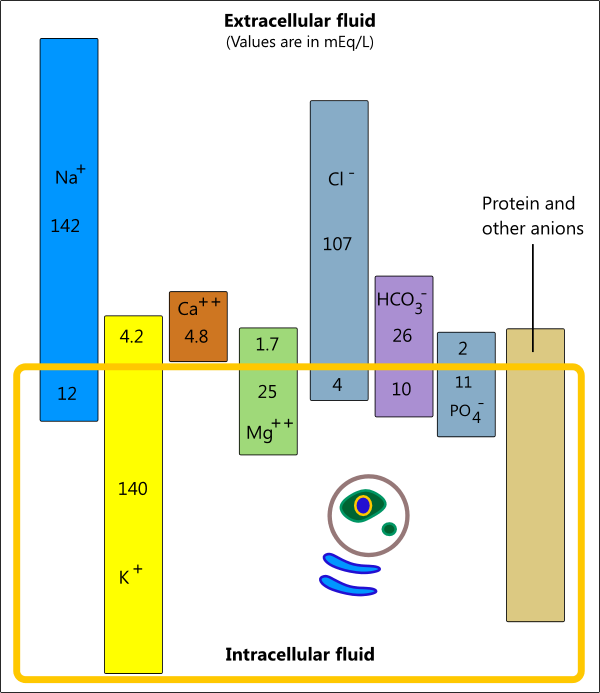Electrolytes Potassium Sodium Chloride Are Measured in What Units
Within the extracellular fluid the major cation is sodium and the major anion is chloride. Electrolytes like sodium potassium and chloride are ions that help regulate the bodys fluid balance.
Potassium The chemical notation for potassium is K.
. The analysis of these parameters was performed by sensor units with selective permeable membranes. Chloride concentration is measured in mEqL conventional units mgdL conventional units or mmolL SI units. MLT Unit 4 electrolytes.
Explore the role of thirst in how. Sodium potassium chloride bicarbonate calcium and phosphate. A Normal blood sodium level is 135 - 145 milliEquivalentsliter mEqL or in international units 135 - 145 millimolesliter mmolL.
The case fatality rates for each of these bands of electrolyte concentrations were calculated and the percent case fatality plotted against the electrolyte concentration. These ions are measured to assess renal kidney endocrine glandular. MEqL x 1 mmolL mgdL 355 mmolL.
Millimoles are the most constant and can be used for all electrolyte atoms and molecules. Therefore any condition that causes a decrease in urinary output also causes potassium retention and the potential for life-threatening consequences. Serum plasma or urine.
The sensor units employ two different measuring principles potentiometry for electrolytes and amperometry for glucose and lactate. The concentration of undetermined anions present in the blood calculated as the difference between the measured total cations and the measured total anions. These electrolytes play an important role in maintaining homeostasis.
Sample considerations Sample type. Sodium and Potassium Once you understand the functions and normal values for electrolytes it is important to understand how some electrolyte levels are related to others. What are some.
As a nursing intervention for. When sodium Na is combined with chloride Cl- the result is sodium chloride NaCl- aka table salt. Mass is a unit of how much Its not the same as weight.
Values are expressed as mmolL for sodium potassium chloride and bicarbonate. Total calcium is usually reported in mgdL and ionized calcium in mmolL. Magnesium results are often reported as milliequivalents per liter meqL or in mgdL.
Sodium chloride and bicarbonate. Excess sodium that is consumed in the diet will be excreted in the urine. For sodium and chloride concentrations these bins were 2 mmolL wide while for potassium concentrations the bins were 028 mmolL wide and for calcium they were 005 mmolL wide.
Potassium is the major positive ion cation found inside of cells. Is an anion gap. How electrolytes are measured.
They are infrequently measured in clinical settings and when they are it is usually in IntensiveCritical care units. The urine electrolytes sodium potassium and chloride are principally used as nutritional indicators in healthy persons. Often an imbalance of one electrolyte is related to an imbalance of another electrolyte so understanding these relationships can assist in.
The units of mass that are used are millimoles milliequivalents or milligrams. Chloride An anion is the negatively charged part of certain substances such as table salt sodium chloride or NaCl when dissolved in liquid. For this project the concentrations of potassium sodium chloride and glucose were measured.
Electrolyte concentrations are similar whether measured in serum or plasma. A Normal blood sodium level is 135 - 145 milliEquivalentsliter mEqL or in international units 135 - 145 millimolesliter mmolL. In this article the etiology signs symptoms and treatments for imbalances of these three electrolytes are reviewed.
A measure of the chemical activity of an ion. The major cation in the intracellular fluid is potassium. The unit conversion formulas are shown below.
The normal blood potassium level is 35 50 milliEquivalentsliter mEqL or in international units 35 50 millimolesliter mmolL. While sodium potassium chloride and bicarbonate are commonly measured together as the electrolyte panel they can also each be ordered individually for diagnosismonitoring of conditions that affect specific electrolytes. Milliequivalent mEq is the unit of measurement used for sodium Na chloride Cl potassium K magnesium Mg calcium Ca and acetate while the millimole mM or the milliequivalent can be used for phosphorus P23 Electrolytes are compounds or substances that dissociate in the solution to release positively.
Roles of Electrolytes These six ions aid in nerve excitability endocrine secretion membrane permeability buffering body fluids and controlling the movement of fluids between compartments. A Normal blood sodium level is 135 - 145 millialentsliter mEqL or in international units 135 - 145 millimolesliter mmolL. Electrolytes are positively and negatively charged molecules called ions that are found within the bodys cells and extracellular fluids including blood plasma.
Their measured values are not diagnostic of any disease in and of. A test for electrolytes includes the measurement of sodium potassium chloride and bicarbonate. Milliequivalents per liter are often used instead of millimoles.
The chemical notation for potassium is K. In terms of body functioning six electrolytes are most important. The kidneys prefer to conserve sodium even when both electrolytes are depleted.

Calculated Contents Of Sodium Chloride And Potassium In Each Deb Level Download Scientific Diagram

Calculated Contents Of Sodium Chloride And Potassium In Each Deb Level Download Scientific Diagram

No comments for "Electrolytes Potassium Sodium Chloride Are Measured in What Units"
Post a Comment